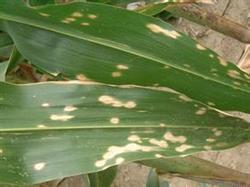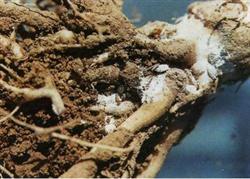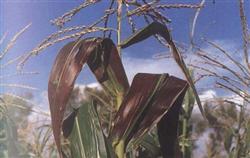Key points of Control techniques of Maize Gray Leaf spot

Gray leaf spot of maize can occur in the whole growth period, but the most serious disease occurs in tasseling and filling stage. Early onset of water-like light brown spots, these spots and veins parallel to the extension, often rectangular, light perspective more obvious, gray spots in the middle, brown lines at the edge. The size of the lesion is 2 - 4×10 - 24 (mm), usually producing gray mold layers on both sides of the leaves, namely the conidia and conidia of the fungus. In the middle and late stages, most of the disease spots combined and the leaves turned yellow and died. This disease is prevalent in our county and has caused great losses to corn production. The key points of its control technology are as follows: 1. Select disease-resistant and high-yield varieties, such as Beiyu No. 2, Haihe No. 1, Beiyu No. 16, Tunyu No. 7, Yayu 889, etc. Second, clean the countryside and reduce the bacterial source base. (1) After corn harvest to before sowing, the residues of corn gray spot disease plants are effectively treated and used as fuel or high temperature compost to reduce the initial infection source of the disease and effectively prevent the occurrence of corn gray spot disease. (2) After maize disease occurs, when the diseased plant rate reaches 70% and the diseased leaf rate reaches about 20%, 2-3 diseased leaves at the lower part of the diseased plant are removed to reduce the reinfection source of the disease. 3. implement health cultivation and disease control. (1) Early sowing in due time, making full use of the light and heat resources in the early stage, can make the dangerous growth of corn stagger with the peak period of disease, and reduce the incidence. (2) Reasonable close planting, standardized cultivation, improve field microclimate, conducive to ventilation and light transmission, enhance plant resistance, prevent disease occurrence. Double row drilling is carried out, with 3500-4000 plants per mu. (3) Balanced fertilization shall be carried out, with 1000-2000 kg of manure, 10 kg of urea, 40-50 kg of calcium phosphate, 10 kg of potassium fertilizer and 1 kg of zinc fertilizer applied per mu as base fertilizer; 15 kg of urea applied per mu for the first topdressing (5-leaf stage), combined with shallow cultivation for weeding; 25 kg of urea applied per mu for the second topdressing (large bell mouth stage), and high cultivation for cultivation. IV. Appropriate selection of corresponding chemicals for prevention and control. 70% thiophanate-methyl, 70% thiophanate-methyl 80 - 100g/mu or 10% difenoconazole 30g/mu mixed with 50kg water were sprayed at the initial stage of disease, at the stage of big mouth opening and at the stage of tasseling and silking respectively.
- Prev

Symptoms of element deficiency in corn
In recent years, the occurrence range of corn sunflower scale has been expanding, and the occurrence degree has increased year by year, which has posed a serious threat to corn production and has become the main pest restricting corn yield. The corn sunflower scale belongs to Homoptera, Coccidae. The insect has 3 generations every year in Hebei Province and is harmful to the second generation (mid-June-early-mid-August).
- Next

Control of Maize Red Leaf Disease
Symptom Huangzao four groups of improved varieties in the filling period in the event of low temperature, overcast and rain, the leaves turn red, which is called red leaf disease. The cause of the disease is related to the rapid filling of this variety, when a large number of synthetic sugars cannot be rapidly transformed into anthocyanins and green leaves turn red due to metabolic disorders. Prevention and control methods (1) serious occurrence areas, not in.
Related
- The first cup of black tea in spring, the flavor and history of tea gardens in Kenya, Africa
- The computer can not only choose potatoes, but also grow tea rice. AI will grow winter oolong tea champion.
- It is not only the inflated tea bitten by insects, but also engraved with the four seasons tea in Beipu.
- The Oriental Beauty Tea Festival in Zhuxian County takes the stage at the weekend to experience the plus-size feast of oil tea.
- & quot; Oriental Beauty Tea & Exploration of Emei in Hsinchu, the hometown of quot;
- The new variety of strawberry "Tainong 1" dessert is the first choice with mellow aroma. Crimson gorgeous
- History of Tea in Taiwan: from Wild Inner Mountain to Export Tea Garden
- Two types of Taiwan Oriental Beauty Black Tea won the British three-Star Award for Childhood Tea Xiang Zhang Jiaqi changed from pilot to champion tea maker.
- Banana species and varieties: the planting history of Taiwan Xianren banana and dwarf banana is long, is banana disease resistant?
- Coffee planting Technology: Qianjie Coffee from Seedling to harvesting

